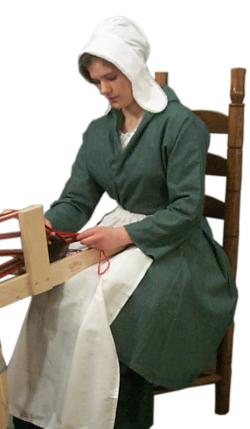

Karen Augusta is selling an elaborately
embroidered apron from the
early 18 century.
Often aprons were made of wool as wool was
more fireproof than any other fabric, and the
working class woman was around fires most of the
day. They were almost always tied
with woven tape ties, which were either sewn to the narrow band to which
the apron was pleated, or were run as a drawstring through a casing at
the waist. The tape was
long enough to wrap around the back and towards the front again. Then the tie was tied and usually tucked into the front of the apron, to prevent loose strings from
catching fire or coming undone.
Usually they were not made with self-fabric ties,
which is how modern aprons are constructed..
Apron at right is offered through
James Townsend.

Here, Chardin's painting,
Girl with
Shuttlecock, (1740)
shows the French
pinner apron. Plucking the Turkey,
by Henry Walton, shows a good
example of a working class woman
with a quite ample checked fabric
apron.